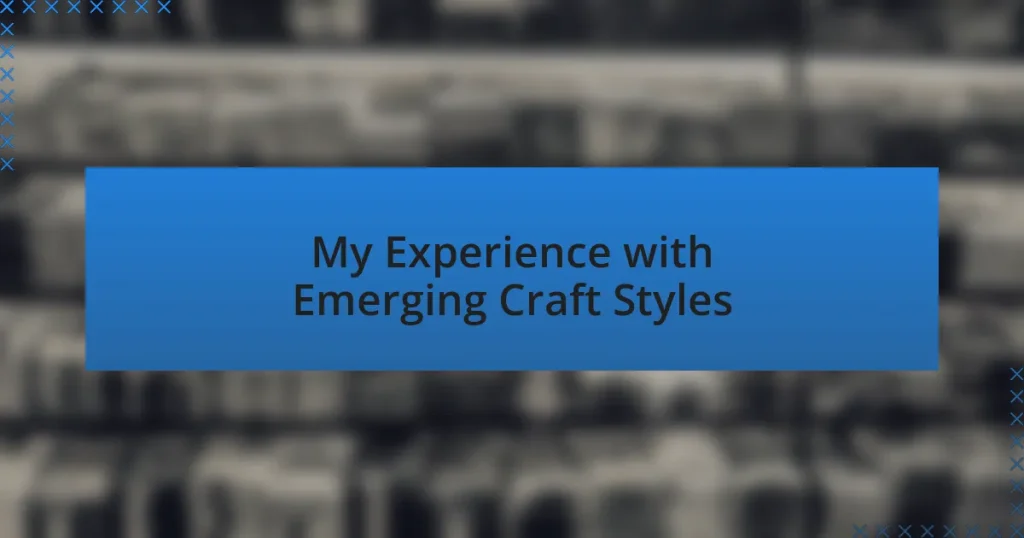Key takeaways:
- Emerging craft styles blend tradition and innovation, promoting sustainability and emotional connections through handmade artistry.
- Craft in fashion emphasizes quality, storytelling, and community, leading to a shift towards more ethical consumer choices.
- Learning new craft techniques encourages perseverance and self-discovery, with each experience offering unique challenges and rewards.
- Engagement with the crafting community enhances creativity and inspiration, fostering collaboration and the exploration of diverse mediums.
Author: Charlotte Hawthorne
Bio: Charlotte Hawthorne is an acclaimed author known for her compelling storytelling and richly drawn characters. With a passion for exploring the complexities of human relationships, her novels often blend elements of romance, intrigue, and self-discovery. A graduate of the University of California, Charlotte has received multiple awards for her work, including the prestigious Silver Quill Award. When she’s not writing, she enjoys hiking in the Sierra Nevada mountains and sipping coffee at local cafes. Charlotte currently resides in San Francisco with her rescue dog, Jasper.
Understanding Emerging Craft Styles
Emerging craft styles are an exciting blend of tradition and innovation, breathing fresh life into what I thought I knew about handmade artistry. I remember visiting a local market and stumbling upon a booth showcasing intricate handwoven textiles that combined age-old techniques with contemporary designs. It made me wonder, how can something so traditional still feel so modern?
The emotional appeal of these crafts is profound. Each piece carries a story, reflecting the maker’s passion and dedication. I often find myself drawn to artisan goods, not just for their aesthetic but for the connection they foster. Have you ever felt that sense of belonging when you wear something that resonates with your values?
As I dove deeper into various craft movements, I discovered an emerging emphasis on sustainability. It struck me that many creators are rejecting fast fashion’s disposable mindset, opting instead for eco-friendly materials and practices. This shift ignites a sense of hope in me—maybe we can redefine our relationship with fashion through these evolving craft styles, one thoughtfully made piece at a time.
Importance of Craft in Fashion
Craft in fashion is more than just a technique; it embodies a commitment to quality and storytelling. I recall attending a workshop where artisans shared their processes, pouring their hearts into every stitch. Watching them work, I realized that this attention to detail transforms garments into wearable art, sparking a feeling of appreciation for the craftsmanship involved. Have you ever felt that connection when you see the effort behind a creation?
The importance of craft is also evident in its ability to create a sense of community. At a recent craft fair, I met designers who not only showcased their products but also shared their journeys and struggles. This connection made each item feel more meaningful. Instead of just another item in my closet, it became a piece of someone’s life story, further enriching my wardrobe and my experience as a consumer.
Moreover, embracing craft can lead us toward more sustainable fashion choices. I’ve started to shift my shopping habits, favoring handmade pieces over mass-produced items. This choice aligns with my values and showcases the hard work artisans dedicate to their craft. How gratifying it is to wear something that not only looks good but also supports ethical practices! Each purchase feels like a vote for a better, more thoughtful fashion industry.
Popular Emerging Craft Styles
As I delve into the world of emerging craft styles, I’ve noticed the rise of macramé, a technique that has made a stunning comeback. I remember visiting a local artisan who transformed simple cords into intricate wall hangings and accessories. Witnessing the transformation from humble materials into something visually captivating left me in awe. Isn’t it fascinating how something so traditional can find its way into modern aesthetics?
Another trend I’ve observed is the resurgence of hand-painted textiles. This craft allows for individual expression, with each piece telling its own story through color and design. I vividly recall a workshop where I experimented with fabric dyes—getting my hands messy but feeling an incredible sense of freedom as I created something uniquely mine. Can a garment truly feel like it’s yours if it carries another’s design, or does its value increase when it reflects your individuality?
What truly stands out to me is the increasing popularity of upcycled fashion. I came across an incredible designer who turns discarded materials into stylish, one-of-a-kind pieces. The thrill of seeing something that would otherwise end up in a landfill transformed into a wearable fashion item is hard to describe. Have you ever thought about how your clothing choices impact the environment? It’s inspiring to see this craft style challenge our perceptions of sustainability while making fashion fun and ethical.
My Journey into Craft Styles
The moment I stumbled into a pottery class, I knew I had found another craft style that would captivate me. I remember feeling the cool, damp clay between my fingers, molding it into a shape that represented my chaotic thoughts and emotions. It was therapeutic, almost like the clay was listening to my inner voice, shaping itself into whatever I envisioned. Have you ever tried your hand at crafting something that spoke to your state of mind?
Another unforgettable experience was my introduction to leatherworking. I recall walking into a workshop filled with the scent of rich leather and the sound of tools at work. As I crafted my first wallet, I felt a sense of pride surge through me—transforming raw material into something functional and beautiful. It made me reflect: isn’t it wonderful how crafting can blend practicality with artistry?
Finally, I’ve recently turned my attention to eco-friendly crafting techniques, such as natural dyeing. I vividly remember the excitement of foraging for plants that would yield beautiful colors, from indigo leaves to vibrant marigolds. The connection to nature reminded me that crafting isn’t just about the finished product; it’s deeply rooted in our environment. Why not embrace the beauty around us and incorporate it into our creative processes?
Learning New Craft Techniques
Learning new craft techniques has been like opening a treasure chest filled with endless possibilities. I distinctly remember my first attempt at knitting; the rhythmic motions of the needles were calming, yet my hands fumbled with the yarn. As I watched those early stitches come together, I couldn’t help but think: isn’t the journey of learning itself a beautiful reflection of perseverance?
Exploring embroidery opened up another dimension for me. I dove into the intricate patterns, all while feeling equal parts frustrated and exhilarated. Each stitch felt like a conversation between my hands and the fabric, and I learned to embrace the imperfections—after all, aren’t our mistakes sometimes the most charming parts of a creation?
Recently, I took a leap into macramé, challenged by its knots and patterns. I remember being tangled in cords, both literally and metaphorically, but with each knot I tied, I felt a rush of satisfaction as my piece transformed. Isn’t it fascinating how the process of learning a new technique can lead to unexpected self-discovery and creativity?
Challenges in Crafting
Crafting often comes with its fair share of challenges that can test our dedication and creativity. I remember a time when I decided to try my hand at pottery. The clay seemed inviting, yet it quickly became a stubborn adversary as it refused to cooperate. It made me wonder: how often do we let our frustration dictate our enjoyment in crafting?
As I delved deeper into crafting, I learned that sourcing quality materials can be a daunting task. I once spent hours scouring local stores only to find the perfect fabric for a project I had in mind. The disappointment of not finding what I envisioned was palpable, but I realized that sometimes the journey to find the right material can lead to discovering unexpected treasures along the way.
Another obstacle that struck me was time management. Juggling everyday commitments while trying to immerse myself in crafting can feel overwhelming. I often find myself asking, “How can I carve out time for my passion without neglecting other important aspects of my life?” It’s tough, but I’ve found that dedicating even small pockets of time can lead to meaningful progress in my projects.
Tips for Embracing Craft Styles
Embracing craft styles begins with letting go of perfectionism. I recall a time when I meticulously tried to match every stitch in my embroidery project, only to find that the quirks made it uniquely mine. It made me question, “Isn’t the beauty of crafting found in the imperfections?” Allowing for those little flaws can lead to a more authentic and enriching crafting experience.
Another vital tip is to explore various mediums and techniques. When I ventured into mixed media, I was amazed at how combining paper, fabric, and paint created a vibrant story. This experimentation not only kept things exciting but also deepened my appreciation for the diverse expressions of craftsmanship. Have you ever tried layering different elements? It’s a fantastic way to discover new favorites and broaden your creative horizons.
Engagement with the crafting community can be incredibly inspiring. I remember attending a workshop where I learned new techniques and met fellow crafters passionate about their projects. The shared enthusiasm was contagious, prompting the question, “How might connecting with others enhance my own crafting journey?” You might find that collaborating or simply sharing ideas with others can unlock new perspectives and motivate you to push the boundaries of your craft.


